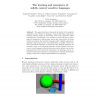Free Online Productivity Tools
i2Speak
i2Symbol
i2OCR
iTex2Img
iWeb2Print
iWeb2Shot
i2Type
iPdf2Split
iPdf2Merge
i2Bopomofo
i2Arabic
i2Style
i2Image
i2PDF
iLatex2Rtf
Sci2ools
ECAL
2003
Springer
2003
Springer
The Learning and Emergence of Mildly Context Sensitive Languages
This paper describes a framework for studies of the adaptive acquisition and evolution of language, with the following components: language learning begins by associating words with cognitively salient representations (“grounding”); the sentences of each language are determined by properties of lexical items, and so only these need to be transmitted by learning; the learnable languages allow multiple agreements, multiple crossing agreements, and reduplication, as mildly context sensitive and human languages do; infinitely many different languages are learnable; many of the learnable languages include infinitely many sentences; in each language, inferential processes can be defined over succinct representations of the derivations themselves; the languages can be extended by innovative responses to communicative demands. Preliminary analytic results and a robotic implementation are described.
| Added | 06 Jul 2010 |
| Updated | 06 Jul 2010 |
| Type | Conference |
| Year | 2003 |
| Where | ECAL |
| Authors | Edward P. Stabler, Travis C. Collier, Gregory M. Kobele, Yoosook Lee, Ying Lin, Jason Riggle, Yuan Yao, Charles E. Taylor |
Comments (0)

